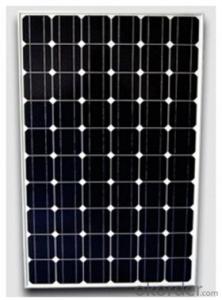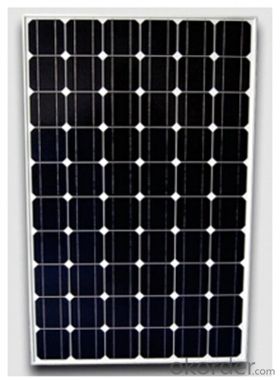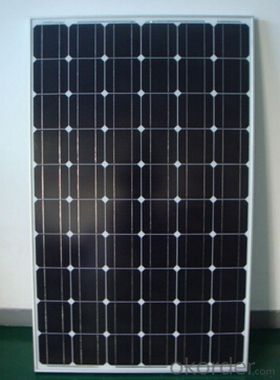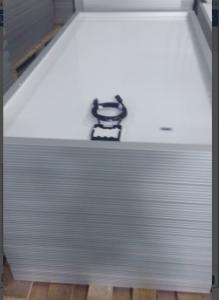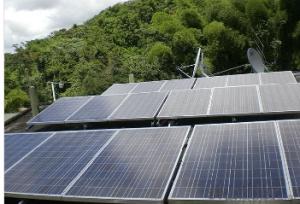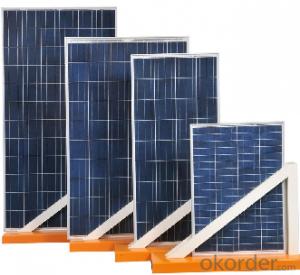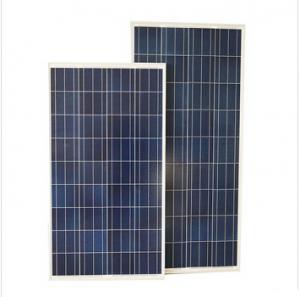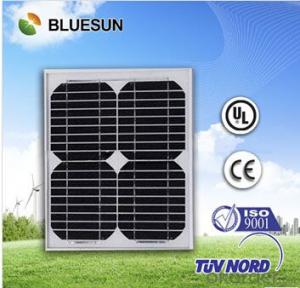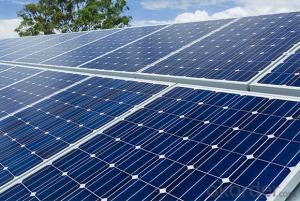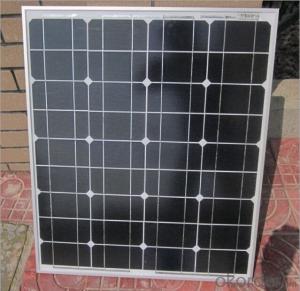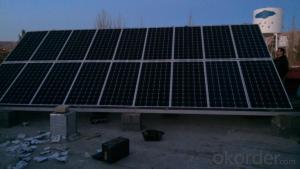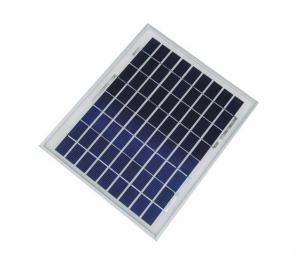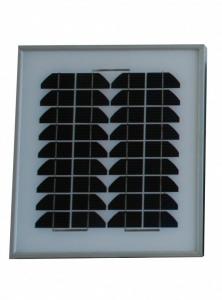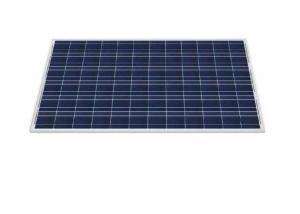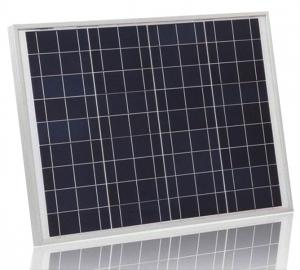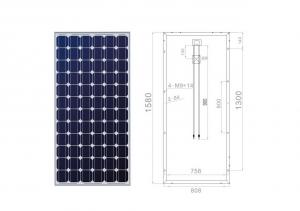Q Cells Monocrystalline Silicon Solar Panel 10-w
- Loading Port:
- Shanghai
- Payment Terms:
- TT OR LC
- Min Order Qty:
- 100 pc
- Supply Capability:
- 100000 pc/month
OKorder Service Pledge
OKorder Financial Service
You Might Also Like
Description:
Monocrystalline Silicon Solar Panel 120W : High efficiency crystalline solar cell. Even if under the weak light, the solar module can produce maximum power output.
II Tempered glass (toughened glass): Anti-reflecting coating and high transmission rate glass increase the power output and mechanical strength of solar module.
III EVA and TPT: Using high quality EVA and TPT to prevent destroying and water.
IV AI frame: Without screw, rner connection. 6 holes on the frame can be installed easily.
V Junction box: Multi function junction box with water proof.
VI Long lifetime: ≥25 years; Less power decrease.
VII Good performance of preventing from atrocious weather such as wind and hails.
VIII Resisting moisture and etching effectively, not effected by geology.
Standard Test Conditions of Monocrystalline Silicon Solar Panel 120W :
The opto-electrical specifications shown below are stabilized values being measured at Standard Test Conditions, Irradiance: 1000W/m2, Spectrum: AM1.5 at 25°C, The info below is subject to manufacturing tolerances. Where appropriate minutes of measurement are available and are used for the dimensioning of the installation.
Advantages of Monocrystalline Silicon Solar Panel
• CNBM Solar performance guarantees for 25 years
• 12 years guarantee for workmanship
• Timeliness of delivery
Specification of Solar Monocrystalline 125mm Series
Characteristics
Max Power Voltage Vmp (V) 17.4V
Max Power Current Imp (A) 0.58A
Open Circuit Voltage Voc (V) 22.4V
Short Circuit Current Isc (A) 0.63A
Max Power Pm (W) 10W
Temperature Coefficient of Cells
NOCT 47℃±2℃
Temperature Coefficients of Isc (%/℃) +0.06%
Temperature Coefficients of Voc (%/℃) -0.33%
Temperature Coefficients of Pmp (%/℃) -0.45%
Mechanical Data
Type of Cells(mm) Poly78×26
Dimension 300×350×25mm
Weight 1.4kg
NO. of Cells and Connections 4×9=36
The dimension of the modules can be changed according to the demand of clients
Limits
Operating Temperature –45 °C to +80°C
Storage Temperature –45 °C to +80°C
Max System Voltage 700V
Guarantee
Products Guarantee 2 yrs free from defects in materials and
workmanship
Performance Guarantee No less than 90% within 10yrs and no less
than 80% within 20yrs
Certificates IEC, ISO, CE
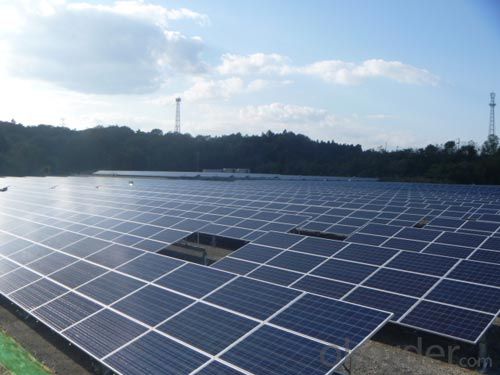

FAQ
We have organized several common questions for our clients,may help you sincerely:
①How to guarantee the quality of the products?
CNBM Solar performance guarantees for 25 years
• 12 years guarantee for workmanship
• Timeliness of delivery
• Quality Products certified (TÜV, UL, CE, ISO)
②How long can we receive the product after purchase?
In the purchase of product within three working days, We will arrange the factory delivery as soon as possible. The pecific time of receiving is related to the state and position of customers.Commonly 7 to 10 working days can be served.
- Q: How do solar panels affect wildlife?
- Solar panels can have both positive and negative impacts on wildlife. On one hand, they can provide shade and shelter for certain species, promoting biodiversity. Additionally, solar farms can be designed to have minimal impact on local ecosystems, preserving habitats and reducing fragmentation. On the other hand, large-scale solar installations may disrupt natural habitats during construction and operation phases, potentially causing displacement or disturbance to some wildlife species. It is crucial to carefully plan and manage solar projects to minimize any negative effects and ensure coexistence with wildlife.
- Q: Do solar panels require regular inspections or maintenance checks?
- Yes, solar panels do require regular inspections and maintenance checks to ensure optimal performance and longevity. These inspections typically include monitoring the panels for dirt, debris, or shading that may reduce their efficiency, as well as checking the electrical connections and wiring for any issues. Additionally, ongoing maintenance such as cleaning the panels and replacing any faulty or damaged components is essential to keep the system operating efficiently.
- Q: Lower solar panel/wind turbine prices allow wider applications, hence a great help to a greener mother earth!
- “the living feed the dead” -- may have actually lucked into the answer. The government does assist the petroleum industry and it funded the research that gave us nuclear power. If alternative energy is going to work, it may require intervention by the government in terms of access to land (imminent domain) and to the transmission grid. Alternative energy companies are stuck because of their own paranoia (of industrial espionage) and because they are being gouged by land owners. A single wind turbine on your land can net you $70,000 a year (plus a 0% increase per year for inflation), forever. Then there is the cost of the corridor to access the grid. Solar companies are trying to purchase land like drunken sailors – and landowners in areas where solar can be most effective (e.g., the American Southwest) are hip to what is going own. So when acquisition agents call to purchase land, owners are demanding outrageous prices (say $5,000/acre for land that is worth about $00/acre, otherwise). Then there is the fact that nobody (rich or poor) wants one in their backyard, not to mention the various PAVE (People Against Virtually Everything) groups who protest stuff just because they can. ===== A Modest Proposal -- <<0% inflation rate is an extremely high You are, of course, right. Nevertheless, that is what some Wind Energy companies are offering land owners as part of the lease agreement for placing turbines on their land. I agree it's outrageous, but I'm an environmental consultant for several Wind companies and I know what they are offering. As a side note. They were initally so lame (and this is related to their general paranoia) that they cut deals to place the turbines before they secured corridor access to substations. When they subsequently approached the land owners (the same ones with the turbines on their land) about the corridor, they were held hostage for outrageous money - as in millions of dollars - because by then the land owners had them over a barrel.
- Q: I'm looking to mount a solar panel to the top of my 2003 Pontiac Montana and was wondering how i could do it without any screws? Magnets maybe?
- In whichever car I'm not using much, I plug in a small solar panel to the cigar lighter socket, and simply place it up on the dashboard. So long as it gets daylight, it's working, it doesn't need full, direct sun. I just slip it between the transmission-tunnel and passenger seat when I get in, and my cars start right on the first turn of the key. It only delivers a very low level of charge, but it's STILL a net-gain, rather than the battery slowly getting a little tired - even the clock in the car, and the armed alarm-system takes SOME current to run, but even the smallest of panels will sort this out for you.
- Q: Can solar panels be used to heat water?
- Yes, solar panels can be used to heat water. Solar water heating systems use the sun's energy to heat water, typically through the use of solar thermal collectors. These collectors absorb sunlight and transfer the heat to water, which can then be used for various purposes such as bathing, washing, or even space heating.
- Q: Can solar panels be installed on agricultural irrigation systems?
- Yes, solar panels can be installed on agricultural irrigation systems. They can provide a sustainable and renewable source of energy to power irrigation pumps, reducing reliance on fossil fuels and lowering operational costs for farmers. Additionally, solar panels are compatible with various irrigation system configurations and can be easily integrated to support the water needs of crop production.
- Q: Can solar panels be used for powering a theme park or amusement park?
- Yes, solar panels can be used for powering a theme park or amusement park. Solar energy is a clean and renewable source of power that can generate electricity to meet the energy demands of such facilities. By installing a sufficient number of solar panels, a theme park can reduce its reliance on traditional grid electricity and lower its carbon footprint. Additionally, the large open spaces within theme parks often provide ample opportunities for installing solar panels, making it a viable option for sustainable energy generation.
- Q: Can solar panels be used to power a skyscraper?
- Yes, solar panels can be used to power a skyscraper. Advanced solar technologies and efficient panel setups can generate significant amounts of electricity, making it feasible to meet some or all of a skyscraper's power needs. However, considering the high energy demands of skyscrapers, a combination of solar power with other renewable sources or grid connection is often employed to ensure a reliable and consistent power supply.
- Q: I would like to know how much a solar panel would cost for a wingspan of 208 ft for a plane
- Build okorder /
- Q: I don't see much solar panels on people's houses where I live. I got a long time to go before doing so but I was planning on buying a few solar panels when I retire in the far future. In your opinion, is such an investment worth it? Would you buy them? I realize they are very expensive hence why I said when I retire. Thanks for your opinion
- I have a boat in a sunny position and four eighty watt panels. These will run my fridge television and a few LED's. I nonetheless need to run my engine for sizzling water and washing desktop. My Batteries only final a couple of years and are an actual affliction. I am going on the mains when i will be able to to get the batteries topped up. The panels are adequate if there's nothing else, they don't seem to be the answer to the way forward for power provide. There's additionally the ethical part of the feed in tariff. For the wealthy to load their electrical power bill onto the less good off just isn't desirable and those panels on the roof inform all of your neighbors that you are doing it. As a way to exhibit a grasping selfish attitude. If they're any just right why don't the vigour companies purchase them and shop shopping coal?
Send your message to us
Q Cells Monocrystalline Silicon Solar Panel 10-w
- Loading Port:
- Shanghai
- Payment Terms:
- TT OR LC
- Min Order Qty:
- 100 pc
- Supply Capability:
- 100000 pc/month
OKorder Service Pledge
OKorder Financial Service
Similar products
Hot products
Hot Searches
Related keywords
